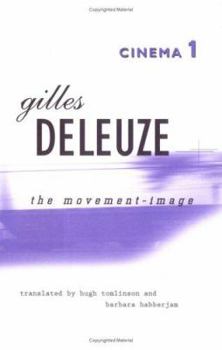Book Overview
Cinema 1 is a revolutionary work in the theory of cinema and begins Deleuze's major reassessment of film, concluded in Cinema 2 . In it, Deleuze identifies three distinct principal types of 'image... This description may be from another edition of this product.
Format:Paperback
Language:English
ISBN:0816614008
ISBN13:9780816614004
Release Date:October 1986
Publisher:University of Minnesota Press
Length:264 Pages
Weight:0.75 lbs.
Dimensions:0.7" x 5.6" x 8.5"
Customer Reviews
3 ratings
Definitely a Classic! a must read!!!
Published by Thriftbooks.com User , 17 years ago
Our Hero Deleuze is back at it once again on his Bergsonian quest to conquer the movement-image.This time descending light from the plane of immanence will guide our hero through phenomenological blunders. Wow! what an amazing book! Deleuze has done it again, I mean talk about the varities! Perception-Image, Affect Image and Action Image. It totally clairfies any misconsceptions about the liquid, gasous and solid states. If there is such thing as a rhizomatic world, could the Time-Image be a prequel? Deleuze is smoking!!!!
A must film and media theorists.
Published by Thriftbooks.com User , 21 years ago
The above review of this book does a great job already, so I will try to complement it as best I can. Deleuze is a difficult thinker for newcomers. His ideas tend to refer to one another and have developed into a complex network of concepts over the course of his writings. The good news is that Deleuze is drawing an immense amount of interest in the US and UK now. Deleuze sets out in the cinema books to create a theory of film and the image that stands in sharp contrast to the film theory we're most accustomed to. Deleuze does not accept that narrativity is a given in film. In fact, he wants to find a way of appreciating and describing what distinguishes film from language and narrative systems. For Deleuze, the moving image is not a system of reference. One doesn't refer to something through a segment of film. The filmic medium is direct, not referential. Cinema 1 is thus a look at how the early cinema learned to produce the "movement image." It's a review of "auteur" film-makers and their experiments with the medium (in addition to those mentioned above are Welles, Godard, Eisenstein, Lang, Resnais, Hitchock...) to produce perception, affect, and action. He contrasts montage with mise-en-scene. He shows how action corresponds to situations, either responding to situations or modifying them. He describes the discovery of depth of field, and use of affect in close ups and still images, the importance of shot and reverse shot sequences, and movement within the scene vs of the camera. He shows how pre-war film maintained a commitment to the whole. Characters' actions were motivated by situations, and films as a whole hung together.The book concludes with Hitchcock's invention of the audience as a third term in the filmic experience: subject, object, audience. Audiences complete Peirce's sign system (firstness, secondness, thirdness) because they interpret the film. Indeed, Hitchcock's art was in showing the audience what the character would only discover later, and in making his films into logical puzzles rather than whodunits. A dazzling book, I had to read it twice, and many of the films referenced won't be on dvd for years....
The finest reflection on cinema.
Published by Thriftbooks.com User , 27 years ago
Gilles Delueze creates in his books on cinema a taxonomy, an attempt at the classification of cinematic images and signs. This classification is an insightful elaboration on Bergson's theses on movement and on Pierce's signs system. If this taxonomy is the core of the "movement-image" book, its heart is a brilliant and systematic history of aesthetic forms of the classical cinema. Some of the more interesting ideas are the two poles of the close-up, Goethe's theory of color and German expressionism, the space in Bresson, an account of Bunuel as naturalist, the difference between John Ford and Howard Hawks, the crisis of the action-image and the essence of comedy as in Lubitsch, Chaplin and Keaton. Nevertheless, it is not a book about cinema, nor is it a book of film history. It is the practice of concepts. Deleuze writes: "Philosophical theory is itself a practice, just as much as its object. It is no more abstract than its object...So that there is always a time, midday-midnight, when we must no longer ask ourselves 'What is cinema?' but 'What is philosophy?'". Only Deleuze, one of the greatest minds of our Century, could answer this question with so much elegance, profundity, ingenuity and mystical charm.





